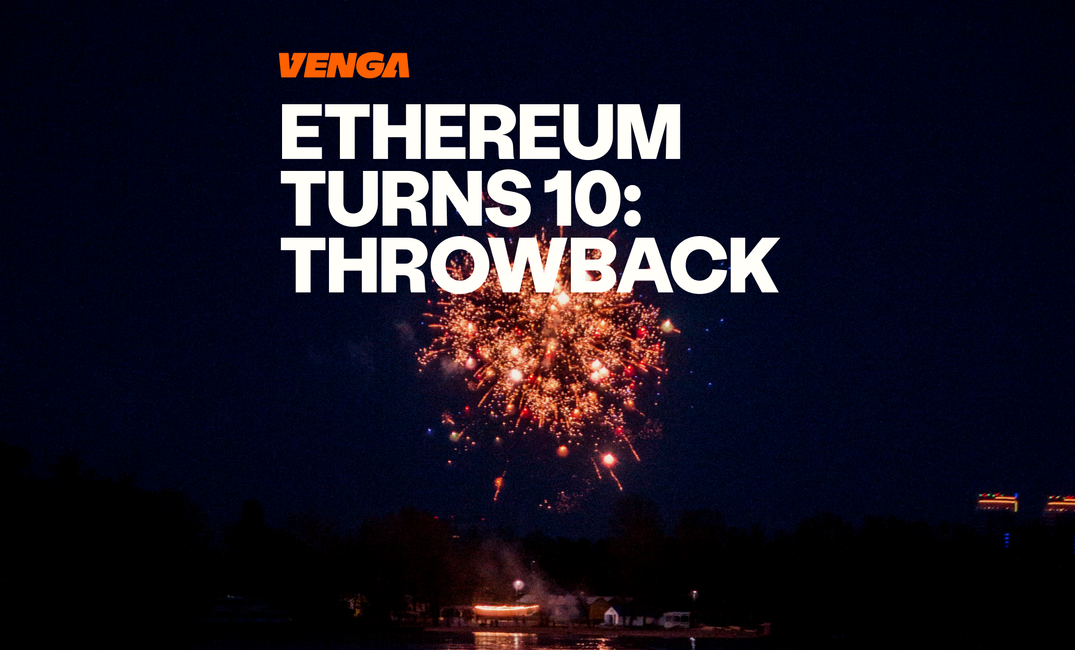Ten years ago, a 19-year-old Vitalik Buterin looked at Bitcoin and thought about what more could be done with this tech. That spark led to the Ethereum project, which officially launched on July 30, 2015, and has completely changed the digital world since.
Over the past decade, Ethereum went from this crazy idea of building a decentralized world computer to actually becoming the infrastructure for most of today’s crypto activity. From smart contracts and NFTs to DeFi protocols and DAOs, Ethereum opened up new horizons for builders and innovation.
So, what happened during these past 10 years? Let’s take a look through Ethereum’s journey.
A 10-Year Ride of Innovation
Ethereum’s history deserves its own Social Network-style movie. It’s packed with achievements, drama, ups and downs… Here’s the quick timeline:
- 2015: Ethereum mainnet went live, smart contracts were introduced, and the concept of programmable money started to make sense.
- 2016: The DAO got hacked, which rocked the ecosystem and resulted in a controversial hard fork splitting Ethereum into two chains: Ethereum (ETH) and Ethereum Classic (ETC).
- 2017–2018: The ICO boom took off with projects raising millions, gas fees skyrocketed also, CryptoKitties appeared, many “innovative” projects and tokens quietly disappeared, and regulators started to notice.
- 2020: The Covid pandemic hit the world hard but Ethereum began to shine bright like a diamond as DeFi took center stage creating a new model for finance.
- 2022: The Merge update finally rolled out, making Ethereum transition from its proof-of-work consensus mechanism to proof-of-stake, cutting its energy consumption by more than 99% along the way.
- 2023–2024: Ethereum’s Layer-2 networks exploded in adoption, staking withdrawals were unlocked, and institutions started to show love mainly through the ETH ETFs.
Meanwhile, ETH’s price went on a rollercoaster of its own, dipping below $100 at some point (what a buy-moment that was), nearly hitting $4,900 at its peak, and now ranging around $3,800. For some time, some people even believed that ETH could “flip” Bitcoin but it didn’t and looks far from it now (the game isn’t over yet though).

So What’s Next?
If we can sum up Ethereum’s first decade as a focus on building the roads of the infrastructure, we can foresee the next one to be about building what travels on top of it and what shapes it.
Here are some of them:
- On-chain Real-world assets (RWAs): Stocks, bonds, real estate, and more, could increasingly be relying on Ethereum, making it become the programmable backend of global finance.
- Enterprise adoption: Governments, banks, and some of the biggest companies in the world might start to use Ethereum-based infrastructures.
- More decentralization and privacy (hopefully): Vitalik’s ETHcc 2025 talk in Cannes was a reminder that decentralization isn’t a marketing term but the mission to protect the users’ autonomy and ownership.
That said, Ethereum still faces friction with fragmented liquidity across Layer-2s, admin keys threatening decentralization, and ecosystem governance that sometimes feels like plutocracy (just with a few extra steps). The dream of unstoppable and user-owned applications is still a work in progress.
Final Words
So yes, Ethereum is now 10 years old. It evolved, far from what it originally was… but still building toward what it aims to be.
It started as a whitepaper, turned into a major ecosystem, and is now on its way to becoming the foundational layer of tomorrow’s internet. Kind of like the web in the ‘90s.
Looking ahead to 2035, Ethereum’s future won’t be defined by how many tokens are staked or how much gas is burned, but by the freedom it provides to the users. Let’s keep building!
Happy Birthday, Ethereum!
Disclaimer: The content provided in this article is for educational and informational purposes only and should not be considered financial or investment advice. Interacting with blockchain, crypto assets, and Web3 applications involves risks, including the potential loss of funds. Venga encourages readers to conduct thorough research and understand the risks before engaging with any crypto assets or blockchain technologies. For more details, please refer to our terms of service.
